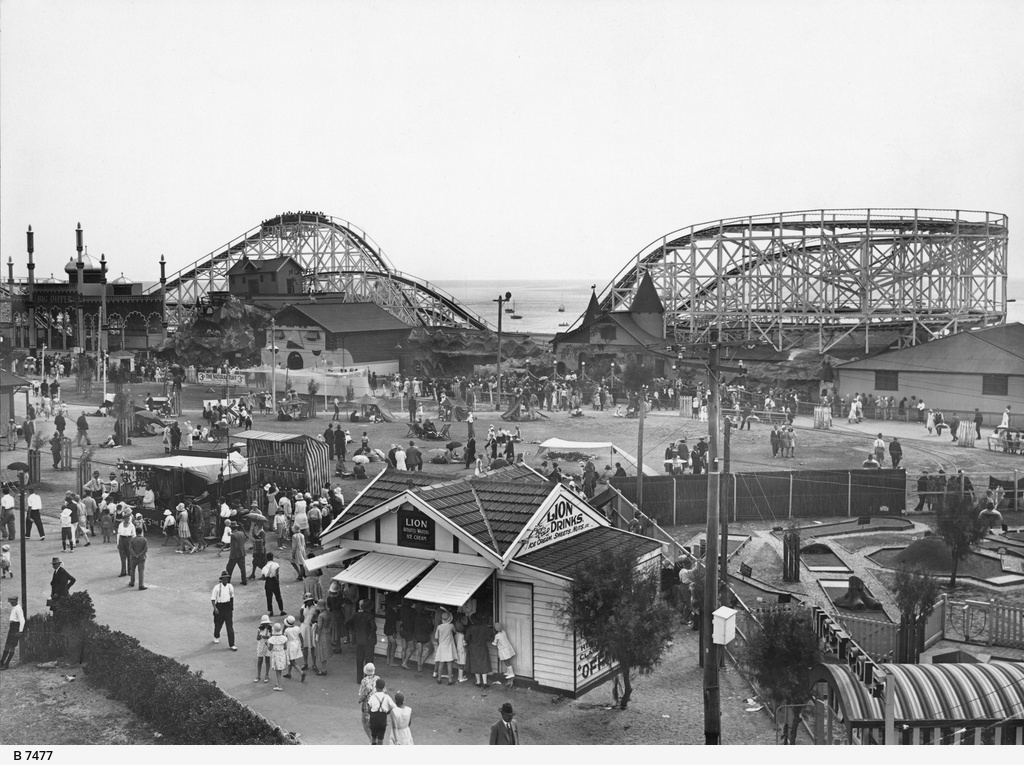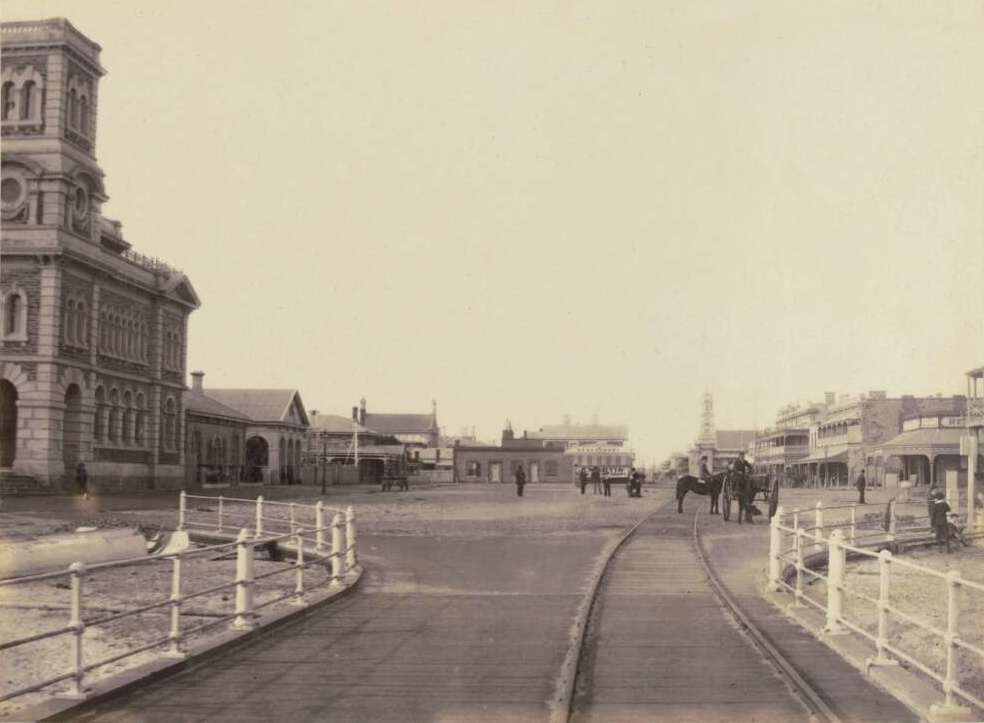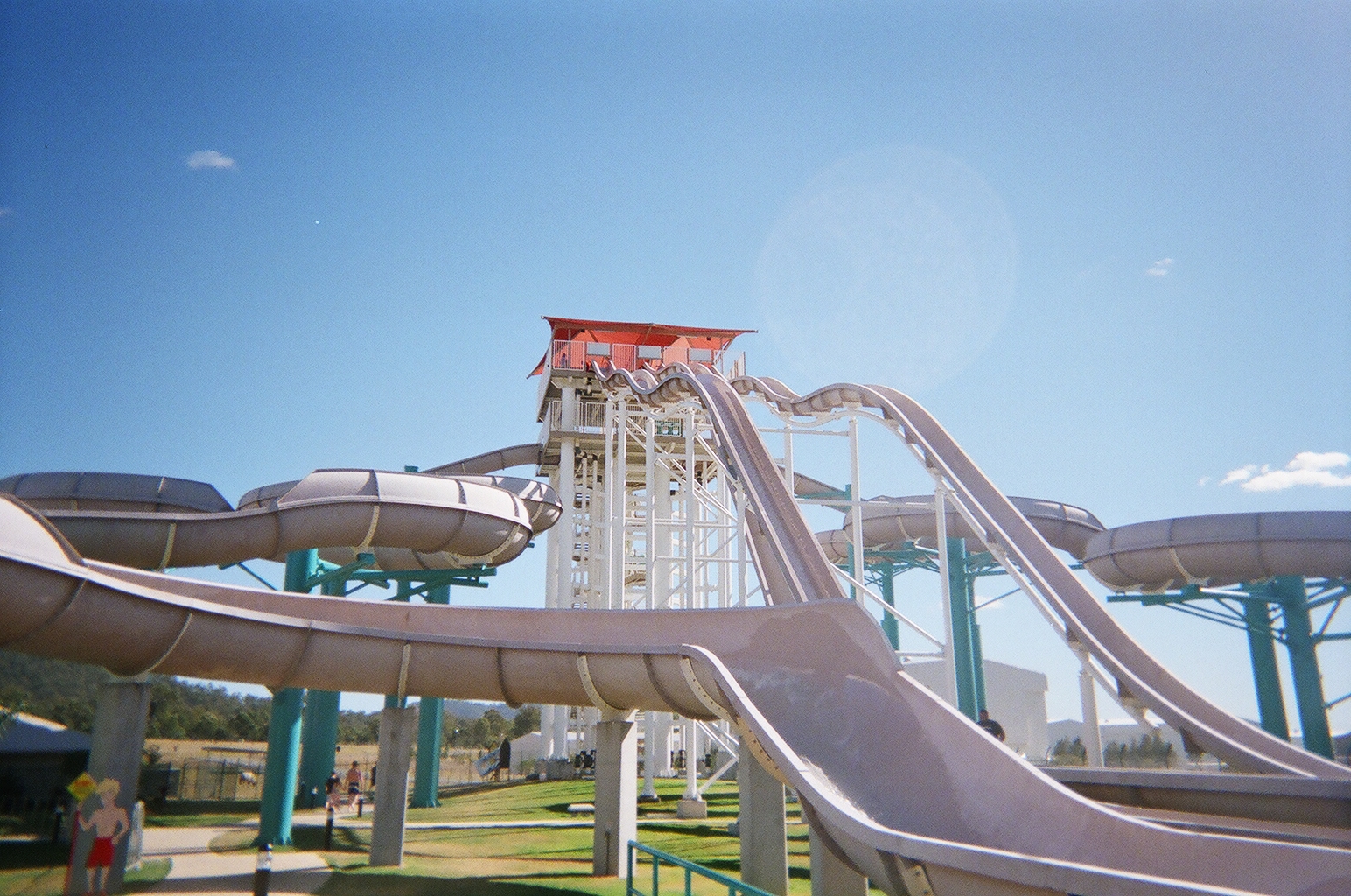|
Luna Park Glenelg
Luna Park Glenelg was an amusement park that operated at Glenelg, South Australia from 1930 until 1935. Plans for an amusement park at the seaside town were first raised in 1928, but not acted upon. In 1929, a lease to build a scenic railway at Colley Reserve was granted by the Glenelg Town Council. This lease was expanded in 1930 to include other rides and attractions (similar to Luna Park Melbourne), and Luna Park Glenelg opened on 8 October 1930. During the park's operation, there was tension between the park's owners and the council, with the owners complaining that they were not making enough to be profitable, and the council refusing to reduce rent or allow increased operating hours. Residents of the town also felt the amusement park was attracting undesirables. The owners began seeking alternate locations, placed the park into voluntary liquidation in late 1934, then purchased the company's assets at auction on 8 April 1935. The rides and amusements were relocated to Sydney ... [...More Info...] [...Related Items...] OR: [Wikipedia] [Google] [Baidu] |
Glenelg, South Australia
Glenelg is a beach-side suburb of the South Australian capital of Adelaide. Located on the shore of Holdfast Bay in Gulf St Vincent, it has become a tourist destination due to its beach and many attractions, home to several hotels and dozens of restaurants. Established in 1836, it is the oldest European settlement on mainland South Australia. It was named after Lord Glenelg, a member of British Cabinet and Secretary of State for War and the Colonies. Through Lord Glenelg the name derives from Glenelg, Highland, Scotland. History Prior to the 1836 British colonisation of South Australia, Glenelg and the rest of the Adelaide Plains was home to the Kaurna group of Aboriginal Australians. They knew the area as "Pattawilya" and the local river as "Pattawilyangga", now named the Patawalonga River. Evidence has shown that at least two smallpox epidemics had killed the majority of the Kaurna population prior to 1836. The disease appeared to have come down the Murray River from ... [...More Info...] [...Related Items...] OR: [Wikipedia] [Google] [Baidu] |
Big Dipper (Luna Park Sydney)
The Big Dipper was a wooden roller coaster operating at Luna Park Sydney from 1935 until 1979. It was demolished in 1981. First constructed in 1930 to an American design, the wooden Big Dipper roller coaster was a mainstay of Luna Park Glenelg during its four years of operation. The ride was dismantled and shipped to Sydney when the Glenelg park went into voluntary liquidation in 1934, and became the biggest attraction of the newly opened Luna Park Milsons Point (which was later renamed Luna Park Sydney). The ride was long, lasted three minutes, could reach speeds of , and when all three roller coaster trains were operating, could carry 72 people. The Big Dipper remained popular throughout its operating life. The coaster became inactive when Luna Park was closed following the 1979 Sydney Ghost Train fire, and was demolished and burned, along with most of the 'old' Luna Park, when Australian Amusements Associates took over the site on 3 June 1981. Two of the nine roller coaste ... [...More Info...] [...Related Items...] OR: [Wikipedia] [Google] [Baidu] |
Amusement Parks In South Australia
Amusement is the state of experiencing humorous and entertaining events or situations while the person or animal actively maintains the experience, and is associated with enjoyment, happiness, laughter and pleasure. It is an emotion with positive valence and high physiological arousal. Amusement is considered an " epistemological" emotion because humor occurs when one experiences a cognitive shift from one knowledge structure about a target to another, such as hearing the punchline of a joke. The pleasant surprise that happens from learning this new information leads to a state of amusement which people often express through smiling, laughter or chuckling. Current studies have not yet reached consensus on the exact purpose of amusement, though theories have been advanced in the fields of psychology, psychiatry, and sociology. In addition, the precise mechanism that causes a given element ( image, sound, behavior, etc.) to be perceived as more or less 'amusing' than another ... [...More Info...] [...Related Items...] OR: [Wikipedia] [Google] [Baidu] |
Lavender Bay
Lavender Bay is a harbourside suburb on the lower North Shore of Sydney, New South Wales, Australia. Lavender Bay is located 3 kilometres north of the Sydney central business district, in the local government area of North Sydney Council. The suburb takes its name from Lavender Bay, a natural feature of Port Jackson (Sydney Harbour) immediately west of the Sydney Harbour Bridge. It lies between Milsons Point and McMahons Point. The suburb North Sydney is located, to the north. Lavender Bay is a residential suburb with expansive views of Sydney Harbour. History Lavender Bay was named after the Boatswain (bosun), George Lavender, from the prison hulk "Phoenix", which was moored there for many years. The bay is dual-named Gooweebahree, (also sometimes written as Quiberee) in the Dharug language of the local inhabitants, the Cammeraygal people of the Eora nation. The colonists also called it Hulk Bay and sometimes Phoenix Bay. George Lavender lived on adjacent to the property of ... [...More Info...] [...Related Items...] OR: [Wikipedia] [Google] [Baidu] |
Sydney Harbour Bridge
The Sydney Harbour Bridge is a steel through arch bridge in Sydney, spanning Port Jackson, Sydney Harbour from the Sydney central business district, central business district (CBD) to the North Shore (Sydney), North Shore. The view of the bridge, the harbour, and the nearby Sydney Opera House is widely regarded as an iconic image of Sydney, and of Australia itself. Nicknamed "The Coathanger" because of its arch-based design, the bridge carries rail, vehicular, bicycle and pedestrian traffic. Under the direction of John Bradfield (engineer), John Bradfield of the NSW Public Works, New South Wales Department of Public Works, the bridge was designed and built by British firm Dorman Long of Middlesbrough, and opened in 1932. The bridge's general design, which Bradfield tasked the NSW Department of Public Works with producing, was a rough copy of the Hell Gate Bridge in New York City. This general design document, however, did not form any part of the request for tender, which remain ... [...More Info...] [...Related Items...] OR: [Wikipedia] [Google] [Baidu] |
Milsons Point, New South Wales
Milsons Point is a suburb on the lower North Shore of Sydney, in the state of New South Wales, Australia. The suburb is located 3 kilometres north of the Sydney central business district in the local government area of North Sydney Council. Milsons Point is also the geographical feature that juts into Sydney Harbour from the northern side, directly opposite Sydney Cove, the spot where the first European settlement was established in 1788. Milsons Point was named after James Milson (1783–1872), one of the earliest settlers. History Milsons Point was named after James Milson (1783–1872), a free settler originally from Lincolnshire. Milson settled in the area near Milsons Point and established a profitable business supplying ships with stone ballast, fresh water, and the produce of his dairy, orchard, and vegetable gardens. In the early 1820s Milson settled in the vicinity of Jeffrey Street, Kirribilli, on 120 acres of land he leased from Robert Campbell (1769–1846). In ... [...More Info...] [...Related Items...] OR: [Wikipedia] [Google] [Baidu] |
The Adelaide Observer
''The Observer'', previously ''The Adelaide Observer'', was a Saturday newspaper published in Adelaide, South Australia from July 1843 to February 1931. Virtually every issue of the newspaper (under both titles) has been digitised and is available online through the National Library of Australia's Trove archive service. History ''The Adelaide Observer'' The first edition of was published on 1 July 1843. The newspaper was founded by John Stephens (editor), John Stephens, its sole proprietor, who in 1845 purchased another local newspaper, the ''South Australian Register''. It was printed by George Dehane at his establishment on Morphett Street, Adelaide, Morphett Street adjacent Holy Trinity Church, Adelaide, Trinity Church. ''The Observer'' On 7 January 1905, the newspaper was renamed ''The Observer'', whose masthead later proclaimed "The Observer. News of the world, politics, agriculture, mining, literature, sport and society. Established 1843". In February 1931, the aili ... [...More Info...] [...Related Items...] OR: [Wikipedia] [Google] [Baidu] |
The Barrier Miner
''The Barrier Miner'' was a daily broadsheet newspaper published in Broken Hill in far western New South Wales from 1888 to 1974. History First published on 28 February 1888, ''The Barrier Miner'' was published continuously until 25 November 1974. Copies are available on microfilm and online via Trove Digitised Newspapers. The paper was revived briefly in 2005; an index to births deaths and marriages has been prepared which also notes additional publication dates between 16 December 2005 and 31 July 2008. The paper closed down for a second time in 2008 with the managing director, Margaret McBride stating that "...due to commercial reasons the paper would no longer service Broken Hill and the region...". ''The Barrier Miner'' served the growing mining community of Broken Hill, when the area was found to have lead ore and traces of silver. It was not until late 1884 or early 1885 that rich quantities of silver were found and the Broken Hill Proprietary Company (BHP) was floated ... [...More Info...] [...Related Items...] OR: [Wikipedia] [Google] [Baidu] |
Glenelg 1930 B-7477
Glenelg may refer to Places Australia * Glenelg, South Australia, a beachside suburb of Adelaide * Glenelg River (Victoria) * Glenelg River (Western Australia) * Glenelg County, Western Australia, a former county * Shire of Glenelg, Victoria * Shire of Glenelg (former), Victoria, abolished in 1994 * City of Glenelg, a local government area in South Australia * Electoral district of Glenelg (South Australia), a former district of the South Australian House of Assembly * Electoral district of Glenelg (Victoria), a former district of the Victorian Legislative Assembly Canada * Glenelg Parish, New Brunswick, Canada * Glenelg, Nova Scotia, Canada, a community * Glenelg, Ontario, Canada, a former township which was merged into West Grey township Elsewhere * Glenelg, Highland, Scotland, a community area and civil parish * Glenelg, Maryland, United States, an unincorporated community * Glenelg, Mars Sports * Glenelg Baseball Club, a member of the South Australian Baseball League * Gle ... [...More Info...] [...Related Items...] OR: [Wikipedia] [Google] [Baidu] |
River Caves
An old mill is a type of amusement park ride with unaccompanied boats floated on guideways through dark tunnels. These themed dark rides originated in the late 19th century and are known by a variety of names, including tunnel of love and river cave. While generally considered a gentle ride, a variation that ends with a climactic splashdown, similar to the modern-day log flume, is known as a mill chute. Tunnel of love In its earliest incarnations, riders were taken by two-passenger boats through dark passages. There were two major themes: a relaxing romantic ride encouraging the couple to cuddle, or a spooky horror ride encouraging the couple to cling to one another. The darkness provided a degree of privacy and the frightening scenes offered a socially acceptable excuse for the physical contact at a time when public affection or even holding hands was considered inappropriate. With the development of other socially acceptable opportunities and less stigma for unmarried couples ... [...More Info...] [...Related Items...] OR: [Wikipedia] [Google] [Baidu] |
Ferris Wheel
A Ferris wheel (also called a Giant Wheel or an observation wheel) is an amusement ride consisting of a rotating upright wheel with multiple passenger-carrying components (commonly referred to as passenger cars, cabins, tubs, gondolas, capsules, or pods) attached to the rim in such a way that as the wheel turns, they are kept upright, usually by gravity. Some of the largest modern Ferris wheels have cars mounted on the outside of the rim, with electric motors to independently rotate each car to keep it upright. These cars are often referred to as capsules or pods. The original Ferris Wheel was designed and constructed by George Washington Gale Ferris Jr. as a landmark for the 1893 World's Columbian Exposition in Chicago; however, wheels of this form predate Ferris's wheel by centuries. The generic term "Ferris wheel," now used in English for all such structures, has become the most common type of amusement ride at state fairs in the United States. The tallest Ferris wheel, th ... [...More Info...] [...Related Items...] OR: [Wikipedia] [Google] [Baidu] |
Water Chute
A water slide (also referred to as a flume, or water chute) is a type of slide designed for warm-weather or indoor recreational use at water parks. Water slides differ in their riding method and therefore size. Some slides require riders to sit directly on the slide, or on a raft or tube designed to be used with the slide. A typical water slide uses a pump system to pump water to the top which is then allowed to freely flow down its surface. The water reduces friction so sliders travel down the slide very quickly. Water slides run into a swimming pool (often called a plunge pool) or a long run-out chute. A lifeguard is usually stationed at the top and the bottom of the slide, so that if a rider gets hurt they will be treated immediately. Traditional water slides Body slides Body slides feature no mat or tube, instead having riders sit or lie directly on the surface of the slide. The simplest resemble wet playground slides. There are a variety of types of body slides in ... [...More Info...] [...Related Items...] OR: [Wikipedia] [Google] [Baidu] |








